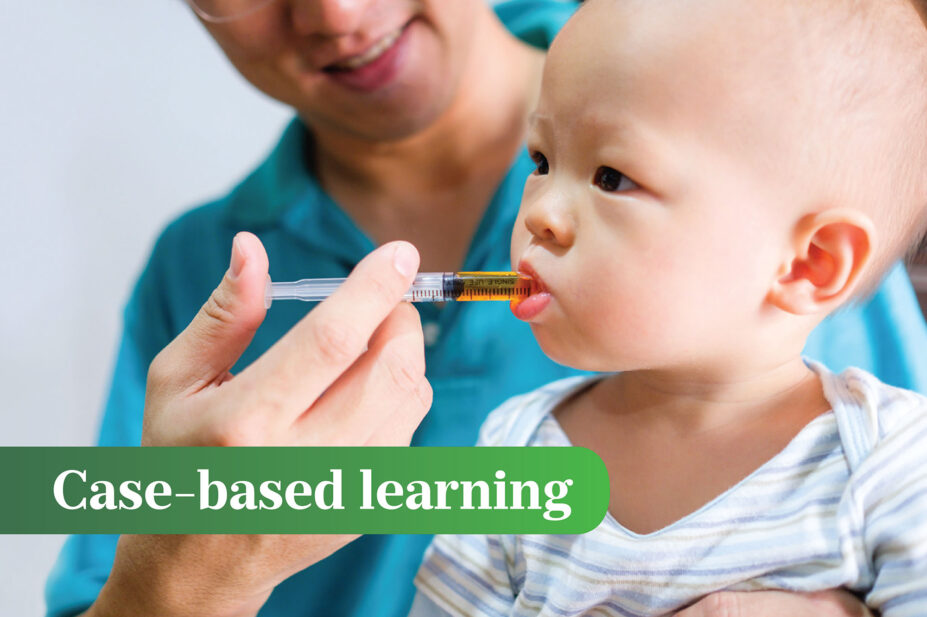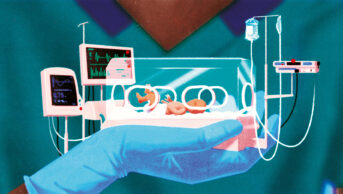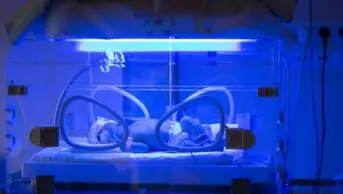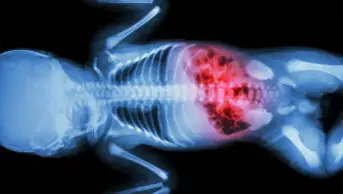
Shutterstock
Oral liquid medicines have historically been considered the most appropriate formulation to prescribe for children[1]. The reasons for this include the perceived inability of children to swallow solid dosage forms, the need for formulations that allow accurate administration of bespoke doses based on age and weight, and the ability to add excipients to improve palatability[1,2]. However, prescribing, dispensing and administering oral liquids to children is not without risk, with one surveillance study of paediatric medication errors indicating that oral liquid medicines were implicated in more than half of the errors reported[3].
One of the main risks associated with prescribing of liquid medicines for children is the variability of available preparations, many with different licensing statuses, excipients and concentrations[4]. Electronic prescribing system drug libraries may list multiple different concentrations of the same liquid medicine and, therefore, it can be difficult for prescribers to determine which product is most appropriate. Parents and carers can become confused if they are supplied with a different concentration than the one they have had previously and with this comes an increase in the potential for dose errors owing to a required change in administration[5,6]. Additional information on dose errors, and other common prescribing errors in children, can be found in ‘Prescribing errors in children: why they happen and how to prevent them’.
This article will cover considerations for the use of oral medicines in children, some of the common errors made when prescribing and supplying these medicines, and how pharmacists can best communicate with patients and carers to reduce the likelihood of dosing and administration errors.
Standardising concentrations of liquid medicines
Parents and carers typically remember — and measure — doses in millilitres, rather than milligrams, which may result in inadvertent dosage errors if a different concentration is supplied without appropriate communication (authors’ observations). Clinicians and pharmacists should endeavour to maintain supply of the same concentration of liquid medicine throughout the course of treatment. Particular care should be taken when patients are transferred between care settings; for example, following discharge from hospital.
Written documentation is essential to reduce ambiguity and confusion over the concentration and formulation to prescribe. If a change to the concentration is unavoidable — for example owing to a supply issue affecting the preferred concentration — the new dose volume should be clearly documented and communicated to the child’s caregiver to reduce the risk of an inadvertent dose error. Correctly sized enteral medicines syringes should be supplied to enable accurate measurement; usually the lowest volume syringe capable of drawing up the prescribed dose[7].
A lack of suitable licensed formulations for children means that in some cases, procurement of an unlicensed medicine may be the most appropriate option. It is estimated that in general practice, at least one in ten medicines prescribed to children are unlicensed or off-label[8] (see Table 1). The Neonatal and Paediatric Pharmacy Group (NPPG) and the Royal College of Paediatrics and Child Health (RCPCH) published a joint position statement on the use of standardised concentrations of unlicensed liquid medicines in children, of which there are currently 13 recommendations[9]. These recommendations are visible in the BNF for Children drug monographs to encourage prescribers and pharmacy teams to prescribe, procure and dispense these specific concentrations, and for healthcare teams to include these concentrations in local prescribing formularies.
Table 1 provides definitions for the types of unlicensed medicines[10–12].
Is a liquid formulation always the appropriate choice?
Not all liquid medicines are suitable for all children. Some liquid medicines contain undesirable excipients, such as ethanol or propylene glycol, in quantities that may be harmful to a neonate or child[13]. For example, the licensed preparation of phenobarbital liquid contains 38% v/v ethanol (equivalent to 39mL of beer or 16mL of wine per 5mL). On a weight conversion basis, the amount of ethanol a 3kg neonate prescribed 7.5mg (2.5mL) of the licensed 15mg/5mL liquid would receive is similar to a 70kg adult consuming 1.5 125mL glasses of wine per dose, which may cause adverse effects, including drowsiness, behavioural changes and hypoglycaemia in children[14].
In the UK, the NPPG and RCPCH recommend the use of an ethanol-free unlicensed phenobarbital 50mg/5mL liquid for children, in preference to the licensed preparation[15]. The manufacturer’s summary of product characteristics may be useful in identifying potentially harmful excipients in licensed liquid medicines[16]. For children prescribed multiple liquid medicines, the cumulative daily excipient intake needs to be considered to prevent harm caused by exceeding the recommended limits. Recommendations on excipient limits may be found in the NPPG/RCPCH joint position statement ‘Choosing an oral liquid medicine for children’[15].
If a liquid formulation of a medicine is unsuitable or unavailable, it may be appropriate to manipulate a solid oral dosage form to deliver the dose. Resources to support dosage form manipulation for patients unable to swallow tablets and capsules can be found in useful resources. Oral modified-release formulations and enteric coated tablets are not suitable for manipulation as the pharmacological activity of the drug is likely to be affected[17].
Swallowing solid oral dosage forms is an important life skill and children who are able and willing to learn should be proactively supported and encouraged to do so. Initiatives such as the KidzMed programme and Pill Schools have been developed to support healthcare professionals to teach pill swallowing to children and young people[18,19]. Solid oral dosage forms typically have a longer shelf-life, less restrictive storage requirements and a lower carbon footprint when compared with liquid medicines[20].
Communicating with patients and carers about the administration of medicines
Administration directions on labels should be clear, explaining the dose to be administered (in millilitres as well as milligrams, if a liquid formulation is prescribed) and the number of times per day the dose is to be given. Complex or multi-step directions for administration, for example crushing and dispersing a tablet, should also be clearly written and include instructions on the diluent volume (see Case study 1).
Pharmacists should feel empowered to challenge prescriptions with ‘take as directed’ administration instructions, as this is unlikely to convey sufficient information to support the person taking or administering the medication safely. A ‘sense check’ of the label directions, or an independent second check within the pharmacy, may help to clarify if the information is likely to be understood by the patient or carer. Pharmacy staff should also ensure that directions are explained verbally to reinforce the message and to check understanding.
Where a dose titration schedule is prescribed, pharmacists may consider the use of supplementary dosing sheets to support young people and their carers to take their medicines (see Case study 3). If a maintenance dose of a drug is prescribed following a dose titration schedule, it is important that both the prescription records and dispensing label are updated to reflect the current dose. Crucially, the patient or carer’s understanding of the administration directions must be checked at the point of handing out the prescription[21]. This is especially important when there has been a change to the prescription.
Case examples
The following cases illustrate scenarios that pharmacy professionals may encounter in primary or secondary care, in which an awareness of the potential risks associated with the use of oral medicines for children is needed and outlines ways to mitigate them, to improve patient safety and prevent harm.
Case 1
The parent of an 8-year-old child visits your community pharmacy to ask for advice on a Friday afternoon. The child is prescribed phenobarbital 50mg/5mL alcohol-free oral suspension (dose 45mg [4.5mL] twice a day) as a ‘special’ for the treatment of seizures. While measuring their child’s phenobarbital dose that morning, the bottle slipped and smashed, leaving them without any medication for the evening dose and for over the weekend.
Phenobarbital is a schedule 3 controlled drug that is subject to controlled drug prescription requirements but is exempt from safe custody requirements[22]. You advise the parent that they will need to obtain a new prescription; however, before contacting the GP you check the available stock in your pharmacy. You identify that you have a bottle of phenobarbital 15mg/5mL elixir on the shelf; however, upon checking the excipients you note that this formulation is not suitable for a child owing to the ethanol content[13]. You decide to telephone neighbouring pharmacies to find out if they have any stock of the preferred formulation, but as it is a ‘special’ with a short expiry date, this is not a preparation that is routinely kept in stock.
Phenobarbital is a category 1 anti-epileptic drug, which means that prescribers and dispensing pharmacists should ensure the continuity of supply of a specific product. If the prescribed product is not available, it may be necessary to dispense a product from a different manufacturer to maintain continuity of treatment[23]. You have phenobarbital 15mg tablets in stock, but you are aware that not all tablets can be safely crushed and dispersed for oral administration. Upon checking the BNF for Children, you confirm that phenobarbital tablets may be crushed for administration by mouth[24].
Following discussion with the child’s GP, they issue an interim prescription for seven days’ supply of phenobarbital 15mg tablets (42 tablets). You explain to the parent how to make a suspension of phenobarbital by crushing the tablets and mixing with water, and the volume that they need to draw up using an enteral syringe to administer the correct dose (see Box 2[24]). You check the parent’s understanding of these instructions and arrange for a follow-up telephone call the following week. You obtain a new prescription for phenobarbital 50mg/5mL alcohol-free oral suspension from the GP and place an order with a specials supplier.
Box 2: Instructions for administering phenobarbital using a suspension of crushed and dispersed tablets
- Phenobarbital dose: 45mg twice a day;
- Crush and disperse three 15mg tablets in 10ml of water and give 10ml (45mg) twice a day.
Case 2
A 2-month-old baby weighing 4.5kg has been discharged from the hospital neonatal unit following surgery for a congenital cardiac abnormality. The discharge summary includes prescribed medicines to be continued by the GP (see Table 2[25]).
Part A
You are a pharmacist prescriber working in a GP practice. The GP asks you to check if these medicines can be prescribed to the infant in primary care. You consult the local prescribing formulary and confirm that these medicines are approved; however, there are multiple concentrations of each liquid listed on the practice electronic prescribing system. You recognise that prescribing a different concentration to what was issued from the hospital on discharge could lead to an administration error, and therefore you contact the hospital pharmacy to confirm the concentration of the liquid medicines. The hospital pharmacist confirms that the following concentrations were supplied:
- Spironolactone 50mg/5ml oral suspension (special);
- Furosemide 50mg/5ml oral solution sugar free[25].
You update the patient’s electronic record with these items (including the liquid concentrations), check that the dose and frequency of each medicine is clinically appropriate using the BNF for Children as a resource and issue the electronic prescriptions.
Part B
You are a community pharmacist. The GP practice sends an electronic prescription for the medicines detailed in Table 2. You have furosemide 50mg/5mL oral solution sugar free in stock, but the spironolactone liquid will need to be ordered from a specials supplier. You contact the supplier and they inform you that delivery will take one week. Currently, spironolactone oral liquid is only available as a special and therefore a prescriber’s letter detailing the special clinical need is not required. You contact the patient’s carer to confirm that they have sufficient supplies of the two medicines at home and place the order.
The following week, you receive the spironolactone liquid. To reduce the risk of dose error, you ensure that the dispensing label includes the dose in millilitres and milligrams, and the frequency of administration (see Box 3). When the parent comes to collect the prescription, you explain the dose instructions for both liquid medicines and check their understanding. Finally, you provide two 1mL enteral syringes (one for each liquid medicine supplied) and the ‘Medicines for Children’ leaflets.
Box 3: Dispensing labels
- Spironolactone: Give 0.5mL (5mg) twice a day;
- Furosemide: Give 0.9mL (9mg) twice a day.
Case 3
You are a pharmacy technician working in the outpatient hospital pharmacy. A parent brings the following prescription to be dispensed for their 6-year-old child (current weight 16kg):
- Prednisolone 20mg once daily in the morning for seven days for flare-up of Crohn’s disease. Reduce by 5mg every week until dose 10mg once daily in the morning, then reduce by 1mg every week until dose 5mg once daily in the morning. Continue on 5mg once daily in the morning until next outpatient review in ten weeks’ time[26,27].
- Omeprazole 20mg once daily whilst taking prednisolone[28].
The pharmacist screens the prescription for clinical appropriateness and to ensure all legal requirements are met before giving the prescription to you for labelling and dispensing. You ask the parent if their child can swallow tablets and they inform you that their child prefers a liquid formulation. You are aware of the variety of enteral prednisolone formulations; however, upon checking the pharmacy inventory, you determine that prednisolone 1mg and 5mg tablets are in stock[26,27]. As there is no guidance on manipulating prednisolone tablets for administration in the BNF for Children, you consult the NEWT guidelines and determine that prednisolone tablets disperse in water within 2-5 minutes[29]. Local practice recommends a volume of 10ml of water for dispersing prednisolone tablets.
You determine that there are two ways that this prescription can be dispensed with the tablets you have available:
- Supply 5mg tablets only. The parent will be required to make a dispersion of tablets and draw up the volume corresponding to the dose. This may require drawing up a portion of the total volume. For example, for an 8mg dose:
disperse TWO 5mg tablets in 10ml of water and give 8ml once daily for 7 days.
There is a risk of inaccurate dosing with this method, as the tablets may not be evenly dispersed in the solvent (water). This could lead to an over- or under-dose[27].
- Supply 5mg and 1mg tablets. The parent will be required to make a dispersion of tablets and draw up the volume corresponding to the dose, but the volume to give will be consistent throughout the course. There is a risk of confusing the two different strengths of prednisolone tablets with this method, which could lead to an over- or under-dose[26].
You decide to discuss these options with the parent to understand which method would work better for them. The parent opts for method 2, as they feel more confident about counting the correct number of tablets than drawing up different volumes for administration with an enteral syringe. You produce a supplementary dosing sheet to support the parent to safely administer prednisolone tablets to their child (see Table 3[26,27]).
You explain the supplementary dosing sheet to the parent, showing them the different tablet strengths and checking their understanding of how to give the required dose(s) to their child. You provide a 10mL enteral syringe and explain that once the tablets have dispersed in water, the dose should be given immediately. You advise that prednisolone should be taken with or just after food[30]. As the steroid course is for a duration of more than three weeks, you provide a blue ‘Steroid Treatment Card’[31].
Lastly, you counsel the parent on administering omeprazole. You have dispensed omeprazole 20mg gastro-resistant tablets: disperse one tablet in 10mL of water and take once daily while taking prednisolone. You advise that the tablet should be stirred to form a cloudy mixture which should be taken within 30 minutes[32]. If desired, a small amount of fruit juice or apple sauce may be added to the solution to improve the taste, but the child must not chew the enteric-coated pellets as this will prevent the desired action[29].
Conclusion
Effective communication between healthcare professionals, parents and carers is critical to reducing potential harm when prescribing and administering medicines to children. Pharmacy professionals should familiarise themselves with the wider potential risks associated with medicines prescribed for children and have robust processes in place to mitigate these risks. Understanding that there is a need for a flexible approach and that ‘one size does not fit all’ is paramount to pharmacy professionals being able to effectively problem solve issues related to medicines use in children. By making use of available resources, clinical judgement and involving the patient and carer, the administration of medicines to children can be optimised to its full potential.
Useful resources
- Neonatal and Paediatric Pharmacy Group position statements;
- BNF for Children;
- The Handbook of Drug Administration via Enteral Feeding Tubes (available in print or online via the Royal Pharmaceutical Society e-Library)[17];
- NEWT Guidelines;
- Medicines for Children;
- Medicines information for parents and carers taking babies home with medicines (PADDINGToN);
- Local formularies, including local paediatric formularies, where available;
- Hospitals with paediatric pharmacy services may have a medicines helpline for queries relating to medicines use for children
- Manufacturer’s summary of product characteristics for checking the excipient content of liquid medicines;
- The Specialist Pharmacy Service has a variety of resources to support paediatric-related medicines queries.
Acknowledgement: The authors wish to express their thanks to Heather Sagoe-Addy for their review of the article and helpful feedback on preparing the case studies.
- 1Nunn T, Williams J. Formulation of medicines for children. Brit J Clinical Pharma. 2005;59:674–6. https://doi.org/10.1111/j.1365-2125.2005.02410.x
- 2Lajoinie A, Henin E, Kassai B, et al. Solid oral forms availability in children: a cost saving investigation. Brit J Clinical Pharma. 2014;78:1080–9. https://doi.org/10.1111/bcp.12442
- 3Tse Y, Tuthill D. Incidence of paediatric 10-fold medication errors in Wales. Arch Dis Child. 2020;106:656–61. https://doi.org/10.1136/archdischild-2020-319130
- 4Patient safety spotlight: the risks of prescribing and supplying medicines to children. General Pharmaceutical Council. 2021. https://www.pharmacyregulation.org/regulate/article/patient-safety-spotlight-risks-prescribing-and-supplying-medicines-children (accessed April 2024)
- 5Rawlence E, Lowey A, Tomlin S, et al. Is the provision of paediatric oral liquid unlicensed medicines safe? Arch Dis Child Educ Pract Ed. 2018;edpract-2016-312132. https://doi.org/10.1136/archdischild-2016-312132
- 6Prescribing errors in children: why they happen and how to prevent them. Pharmaceutical Journal. 2023. https://doi.org/10.1211/pj.2023.1.184013
- 7NHS Electronic Drug Tariff. NHS Business Services Authority. 2024. https://www.drugtariff.nhsbsa.nhs.uk/#/00851870-DD/DC00851864/Home (accessed April 2024)
- 8National Service Framework for Children, Young People and Maternity Services. Department of Health and Social Care. 2004. https://www.gov.uk/government/publications/national-service-framework-children-young-people-and-maternity-services (accessed April 2024)
- 9Using standardised concentrations of unlicensed liquid medicines in children – joint position statement (Version 9). Neonatal and Paediatric Pharmacy Group and Royal College of Paediatrics and Child Health. 2023. https://nppg.org.uk/wp-content/uploads/2023/08/NPPG-Position-Statement-18-01-V9-July-2023.pdf (accessed April 2024)
- 10Guidance note 14: The supply of unlicensed medicinal products (“specials”). Medicines and Healthcare products Regulatory Agency. 2012. https://assets.publishing.service.gov.uk/media/645e19f5ad8a03000c38b3bc/The_supply_of_unlicensed_medicinal_products__special_GN14.pdf (accessed April 2024)
- 11Understanding unlicensed medicines. Specialist Pharmacy Service. 2023. https://www.sps.nhs.uk/articles/understanding-unlicensed-medicines/#:~:text=specials (accessed April 2024)
- 12Explaining the licensed status of medicines. Specialist Pharmacy Service. 2023. https://www.sps.nhs.uk/articles/explaining-the-licensed-status-of-medicines (accessed April 2024)
- 13How to identify and manage ‘problem’ excipients in medicines for children. Pharmaceutical Journal. 2017. https://doi.org/10.1211/pj.2017.20203121
- 14Phenobarbital Elixir BP Thornton & Ross Ltd Summary of Product Characteristics. Electronic Medicines Compendium. 2023. https://www.medicines.org.uk/emc/product/4920/smpc (accessed April 2024)
- 15Choosing an oral liquid medicine for children – joint position statement (Version 1). Neonatal and Paediatric Pharmacy Group and Royal College of Paediatrics and Child Health. 2020. https://nppg.org.uk/wp-content/uploads/2020/12/Position-Statement-Liquid-Choice-V1-November-2020.pdf (accessed April 2024)
- 16Electronic Medicines Compendium. Electronic Medicines Compendium. https://medicines.org.uk/emc (accessed April 2024)
- 17White R, Bradnam V. Handbook of Drug Administration via Enteral Feeding Tubes. 3rd ed. London: Pharmaceutical Press on behalf of the British Pharmaceutical Nutrition Group 2015. https://rudiapt.files.wordpress.com/2017/11/handbook-of-drug-administration-via-enteral-feeding-tubes-2015.pdf (accessed April 2024)
- 18KidzMed. E-Learning for Healthcare. https://www.e-lfh.org.uk/programmes/kidzmed/ (accessed April 2024)
- 19Rashed AN, Terry D, Fox A, et al. Feasibility of developing children’s Pill School within a UK hospital. Arch Dis Child. 2020;106:705–8. https://doi.org/10.1136/archdischild-2020-319154
- 20Lim E, Parker E, Vasey N. Why learning how to swallow pills is good for patients, parents, and the planet. BMJ. 2024;e076257. https://doi.org/10.1136/bmj-2023-076257
- 21Communicating with parents and involving children in medicines optimisation. Pharmaceutical Journal. 2017. https://doi.org/10.1211/pj.2017.20203683
- 223. Underpinning Knowledge – Legislation and Professional Issues. Medicines Ethics and Practice. 2023. https://www.rpharms.com/mep/3-underpinning-knowledge-legislation-and-professional-issues/36-controlled-drugs/369-safe-custody#gsc.tab=0 (accessed April 2024)
- 23Antiepileptic drugs: updated advice on switching between different manufacturers’ products. Medicines and Healthcare products Regulatory Agency. 2017. https://www.gov.uk/drug-safety-update/antiepileptic-drugs-updated-advice-on-switching-between-different-manufacturers-products (accessed April 2024)
- 24Phenobarbital: directions for administration. British National Formulary for Children. https://bnfc.nice.org.uk/drugs/phenobarbital/ (accessed April 2024)
- 25Furosemide 50mg/5ml oral solution Summary of Product Characteristics. Electronic Medicines Compendium. 2017. https://www.medicines.org.uk/emc/product/4574/smpc# (accessed April 2024)
- 26Prednisolone 1mg tablets Summary of Product Characteristics. Wockhardt UK Ltd. Electronic Medicines Compendium. 2021. https://www.medicines.org.uk/emc/product/2428 (accessed April 2024)
- 27Prednisolone 5mg tablets Summary of Product Characteristics. Wockhardt UK Ltd. Electronic Medicines Compendium. . 2021. https://www.medicines.org.uk/emc/product/2427/smpc (accessed April 2024)
- 28Omeprazole 20mg Capsules . Electronic Medicines Compendium. 2023. https://www.medicines.org.uk/emc/product/4895/smpc#gref (accessed April 2024)
- 29Prednisolone. The NEWT Guidelines for administration of medication to patients with enteral feeding tubes or swallowing difficulties. https://access.newtguidelines.com/P/Prednisolone (accessed April 2024)
- 30Prednisolone: medicinal forms. British National Formulary for Children. https://bnfc.nice.org.uk/drugs/prednisolone (accessed April 2024)
- 31Prednisolone: patient and carer advice. British National Formulary for Children. https://bnfc.nice.org.uk/drugs/prednisolone (accessed April 2024)
- 32Losec MUPS tablets 20mg Summary of Product Characteristics. Neon Healthcare Ltd. Electronic Medicines Compendium. 2023. https://www.medicines.org.uk/emc/product/1514/smpc (accessed April 2024)


